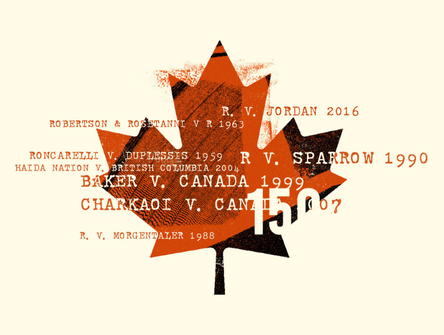Addressing the legal services gap
How British Columbia is leading the way in modernizing regulation of the legal sector.

In May 2022, a group of paralegals filed a motion before the Law Society of Ontario that was meant to land with the slap of a gauntlet being thrown — and ended up sounding more like a damp squib.
The motion — rejected for procedural reasons by the LSO's treasurer — called on the government of Ontario to take over the regulation of lawyers in the province. The paralegals argued that, because the LSO had dropped the Family Legal Service Provider (FLSP) report from the February 24 convocation agenda — essentially punting on the question of permitting paralegals to represent separating individuals in family court — it had ceased to be a self-regulating body acting in the public interest and was acting in the interests of lawyers alone.
The motion vanished with little trace, getting no attention from mainstream media outlets. But to many critics of the current model of self-regulation in Canada's legal sector, the motion's obscurity mattered much less than the warning it delivered: that self-regulation could expose the sector to accusations of self-dealing and — once such an impression takes hold in public opinion — government-driven regulatory reform of the sort that happened in the U.K. and elsewhere might be the next step.
"I wasn't surprised by the motion. It's not a new idea," said Lisa Trabucco, an assistant professor of law at the University of Windsor who has written extensively about legal profession regulation and access to justice. "The LSO is the regulator — that's the reality.
"But I don't think (government regulatory takeover) is nearly as far off as some lawyers seem to think. I think it's entirely possible that some province will follow the U.K.'s example."
Possible — because that motion didn't emerge in a vacuum. Just months before the paralegals' motion landed, the celebrated U.K.-based professional governance consultant Harry Cayton submitted his long-awaited governance review to the Law Society of British Columbia (LSBC). In it, Cayton found that the LSBC meets seven of nine prescribed standards of good governance. But it established a theme that was picked up by the paralegals in their motion before the LSO months later — by saying that the law society "acts more like a professional association than a professional regulator."
Cayton argued this tilt toward lawyers' interests over public need — toward aspects of the LSBC's governance that he said one would "expect to see in the structure of a trades union or political party rather than an oversight body accountable to the public" — is baked into the way the LSBC governs itself and the profession.
"The members elect, and do so frequently, the substantial majority of the benchers who govern them," Cayton wrote.
That arrangement sets up a predictable tension between the law society's mandate — to protect and serve the public interest — and the source of benchers' authority, Cayton said.
"Regulatory boards should not be beholden to the profession they regulate but to the public they serve," he wrote. "A board that is only interested in its shareholders or members and not its customers or its public duty will inevitably fail."
Cayton recommended various measures to put distance between benchers and lawyers. He said the LSBC should reduce the number of elected benchers and increase the number of appointed ones, to diminish the risk of law society policy being dictated by (or being seen to be dictated by) political considerations.
"Through their control of the Society through elections and resolutions at the (annual general meeting)," Cayton wrote, "members often thwart regulation in the public interest. The Society's active responsiveness to the profession is in stark contrast with its lack of engagement with the public or legal clients.
"Some benchers suggested to me that the Society should consult the profession even more regularly and widely. I take the view that the Society engages inappropriately with the profession."
Cayton called on the LSBC to extend terms of office so that benchers serve for two terms of four years and presidents and vice-presidents serve for "at least" two years. "Benchers serve for only two years before having to stand for re-election," he wrote, "so their attention is directed inevitably to their constituency of fellow lawyers rather than to the public."
His recommendations got some positive reviews in B.C.'s legal sector. The Canadian Bar Association's B.C. branch, in its submission to Cayton's review, agreed with Cayton's call for a much clearer division between the LSBC's role as regulator and the work of advocating for the profession (technically, the CBA's job).
"LSBC should consider whether its activities are acting to blur the distinction between itself and professional associations like CBABC," the submission says. "If the public or lawyers perceive that LSBC and CBABC are engaging in similar activities, they may perceive them as playing similar roles, which could damage LSBC's position as an independent regulator."
Consequently, the CBABC called on the LSBC to back away from its work as a lobbyist registered with the provincial government. "Lobbying or advocacy efforts beyond changes to the Legal Profession Act may interfere with LSBC's mandate to protect the public interest and should be left to bodies such as CBABC," says the CBABC's submission.
The CBABC is less enthusiastic about the idea of appointing more benchers. "The question of appointed versus elected gets at the heart of the issue of independence," said Clare Jennings, former CBABC president whose term recently ended.
"If government is doing the appointing, what happens to the public's perception of the legal profession's independence? Remember, we're the profession that frequently stands between the individual and the state."
As it happens, mere months after the release of the Cayton Report, the B.C. government announced its intention to create a single regulator in the province for lawyers, notaries, and paralegals — all with a view to better protect people accessing legal services and help improve access.
The reforms contemplated by the province would establish a board of directors on which the government-appointed members would constitute a minority. However, the government was careful to say it would not interfere with the legal profession's independence, indicating it would no longer have the Attorney General sit as a board member. The governance board would also be composed of "licensee" directors elected by licensees, and directors appointed by the other members of the bar.
It's early days yet, as the government is seeking input from the public and key stakeholders in the legal sector before it puts forward draft legislation. Still, B.C.'s modernization effort could signal a more significant evolution in how legal services are regulated across Canada.
One inescapable aspect of Cayton's report — which the government's intentions paper also raises — is how it loops back to the matter underlying the need to modernize the regulation of the legal profession: access to justice.
Cayton singles out for praise the LSBC's "innovation sandbox" — a regulatory project launched in 2021 that allows "non-traditional" providers of legal services (like paralegals) to test out new ways of delivering those services. (Think of it as an audition call for regulatory reform.)
"The 'innovation sandbox' is more clearly aligned with the public interest, that is, the interest in access to justice," Cayton wrote. "It recognises that the current provision of legal services does not meet the needs of all B.C. citizens and seeks to pilot a range of different kinds of services to meet those needs."
B.C.'s sandbox project came on the heels of a similar effort in Utah months earlier. The Law Society of Ontario's technology task force, made up of lawyers, paralegals and publicly appointed lay benchers, launched a regulatory sandbox in 2021 to test out the role new technologies could play in improving access to justice. Alberta launched its own sandbox in 2021 to "encourage and foster innovation in the delivery of legal services."
If it's a trend — and it certainly looks like various North American constituencies are experimenting with ways to modernize their legal markets — it's one Craig Ferris and his colleagues saw coming years ago.
Ferris was the LSBC's president in 2020 when work began on the sandbox. He predicts a decentralized future market for legal services — one where "we could see things like grocery stores setting up their own in-store legal services kiosks." And he argues the legal profession can't expect to maintain a monopoly on legal services without addressing the needs of people who can't afford a lawyer.
"If we're not going to provide the legal service ourselves, we shouldn't be denying others the right to provide it," said Ferris, a partner at Lawson Lundell. "In the U.K., they have a limited number of areas of practice reserved for the bar, and the rest is open to pretty much anyone."
Canada has an access-to-justice problem — or a crisis, depending on who's describing it. Research published by the Department of Justice estimated that, based on provincial and territorial stats from 2012, between 40% and 57% of parties in family law cases were going to court without representation.
"Surveys of judges, lawyers and other [family justice service] professionals indicate that they believe the number of SRLs [self-represented litigants] has increased over the last five years, estimating that between 50 per cent and 80 per cent of parties to civil/family actions are self-represented," says a department media release from 2016. While the department acknowledged "there are no national, public data on the number of SRLs in Canada," it's hard to conceive of any factor that would have slowed the trend toward self-representation in family law in the years since.
"A great many people simply can't afford a lawyer. And it's not just the poor — it's the middle class as well," said Jennifer Leitch, executive director of the National Self-Represented Litigants Project (NSRLP), which conducts research and advocates on behalf of Canadians in the justice system who can't find or afford lawyers.
"If you're making $60,000 to $90,000 a year and you have a mortgage and a family, are you in a position to put down a retainer of, say, $7,000 to $8,000 for a litigation matter?"
Self-represented litigants find themselves at a disadvantage at almost every stage of a case, Leitch said. Legal aid is of little use to them — either because it's often restricted to criminal cases in the jurisdiction where they live, or because access is limited to very low-income litigants, or because there just isn't enough of it to go around.
"The legal aid ship has sailed," said Leitch, who argues that it's just not politically practical to expect any provincial government to expand legal aid to cover everyone needing representation in civil, family or immigration law.
"I'm not defending the chronic underfunding of legal aid — it's atrocious — but you would be talking about a vast amount of money to expand it to cover everyone in need."
Many critics of the way legal services are regulated in Canada argue that law societies need to do more to open up legal markets to new players — that resistance to such efforts indicates a reluctance to face competition, even if that competition could serve the public interest.
"This is where something like the Cayton paper is very useful," said Richard Devlin, professor of law at Dalhousie University. "His observations of benchers showed more concern for the professional interests of lawyers and less for the interests of the wider public.
"There is a fundamental disconnect, a contradiction, in the self-regulatory model. One cannot serve two masters."
The Family Legal Services Provider (FLSP) licence proposal that was supposed to be on the LSO's Feb. 24 convocation agenda was intended to help address the problem of self-represented litigants. It would have allowed paralegals to represent splitting couples by, among other things, drafting contracts for them and acting for them in court. (When asked for an update on the proposal's status, the LSO said it continues "to receive valuable input from stakeholders across the justice sector" and is "considering next steps.”)
Sarah Boulby, a family and divorce lawyer and partner at Boulby Weinberg LLP in Toronto, said she believes the FLSP report was doomed to defeat at the February convocation because most Ontario lawyers believe it's a bad idea.
"The problem is the prospect of people who aren't qualified to do the work being certified by the law society as if they are," she said. "The public will assume that anyone certified by the LSO is competent. Nobody can tell the difference between a good doctor and a bad one on a first encounter — that's why we have professional regulatory bodies."
Boulby also questioned the claim underlying the FLSP proposal — that paralegals could handle less-complex family law cases more cheaply than lawyers. A January report by the LSO's Access to Justice Committee found that paralegals were charging an average of $144 per hour, while family lawyers were charging an average hourly fee of $330.
Boulby argues the cost advantage paralegals enjoy would be blown away by the higher insurance premiums they'd have to swallow once they start dealing with divorces.
"We've never seen a business plan," she said. "They'd have to run their offices like we do, with the same basic overhead
"Paralegals' insurance premiums are low now because they're not dealing with complex, costly cases. What happens to those premiums when they're handling divorce cases involving million-dollar properties?"
The degree to which public perception of lawyers is driven by individuals' experiences of the justice system — of the high cost of legal representation and the risks involved in flying solo — can be debated.
What can't be denied, said legal industry analyst Jordan Furlong, is that money is a significant factor in how the justice system is perceived.
"Lawyers like to say, 'We're not all rich.' That's true, I get that," he said. "But I don't think the average lawyer understands just how close to the bone many Canadians live financially, how the loss of $500 can mean the difference between eating and not eating.
"The message lawyers have been sending to the public for a long time now is twofold. First, only lawyers can represent you in legal matters. Second, if you can't afford a lawyer, you have no other options available to you. The pricing of lawyers' services is such that only a small percentage of people who need one can afford one. If you're telling people that their only alternative to a service they need but can't afford is to go without, that's not an argument."
Critics like Furlong see resistance to opening up legal services markets as a natural outgrowth of a self-regulation model that allows lawyers to choose the people doing the regulating.
"The same basic flaw is present in all of Canada's law societies," he said. "When you have a regulator whose directors are chosen in large part by the people the regulator is supposed to regulate, it is a very short distance to a state of regulatory capture."
Those seeking alternatives to Canada's approach to self-regulation have no shortage of models from abroad to study. In Australia — where, as in Canada, lawyers are regulated at the state/provincial level — bodies appointed by government handle the complaints and disciplinary processes, while law societies maintain authority over rules and standards of practice.
The United Kingdom went much further. After the government launched a review of the country's legal sector that uncovered a familiar litany of flaws (rising prices and too many restrictions on who could advocate), Westminster introduced a Legal Services Board in 2009 tasked with monitoring the regulation of lawyers in England and Wales.
The LSB sits atop the English/Welsh legal sector regulatory pyramid, overseeing the work of regulators for the various legal professions. It's designed to be both politically and financially independent of government; its costs are covered by levies on the regulators.
Among other things, the LSB is responsible for ensuring regulators pursue eight regulatory objectives defined by law — which include "protecting and promoting the public interest," improving access to justice and looking out for the interests of consumers.
The LSB in 2009 launched the Legal Services Consumer Panel, which advises the LSB on issues of importance to individual consumers of legal services. The law that established the LSB also permitted the launch of "alternative business structures" (ABS firms) owned or managed by non-lawyers — an attempt to open up the legal services market to competition, drive down costs and improve access to justice. ABS firms have been licensed in Arizona since 2021, Utah has permitted them in its regulatory sandbox since 2020 and market liberalization is being studied in other U.S. states as well.
"My gut feeling is that we should at least try [the U.K. model of] oversight regulation for a while. It's the least radical first step," said Devlin. "We could attempt it for a period of time before evaluating its effectiveness.
"It's interesting. Reform in the U.K. came about under a government which expressed the concern that citizens were not getting good value for their money from the legal profession. They approached it from the point of view of consumers' rights.
"A future (Canadian provincial) government with the same ideological bent could take similar action, as could a future government which sees reform as an essential part of the pursuit of social justice."
Others see the prospect of a provincial government taking on a U.K.-style revamp of legal sector regulation as unlikely. Access to justice — unlike access to health services — has never been much of a talking point in Canadian politics.
"I think it might have something to do with Canada's political culture," said Noel Semple, an associate professor at the University of Windsor Faculty of Law who studies access to justice issues. "In the U.K. and Australia, you have political cultures that are more individualist, more focused on the rights and needs of the individual consumer.
"And it's very easy to blame people for their misfortunes when they've been charged with a crime. Most people can't imagine ever getting sucked into the justice system for any reason. That makes it easier for them, and for politicians, just to brush off these problems as, 'they had it coming.'"
In the absence of political pressure driving reform, said Furlong, lawyers are left with a conundrum: their image is unlikely to improve among average Canadians until average Canadians' experiences of the justice system improve substantially.
"Lawyers should look upon the state of their public image as a call to action to reform," he said. "If you can send a message that the profession supports the expansion of legal services through the introduction of new skilled professionals, that would help. You can't have a fair legal system unless the average person has realistic access to legal advice.
"You want to improve the image of the profession? This is the best place to start."


